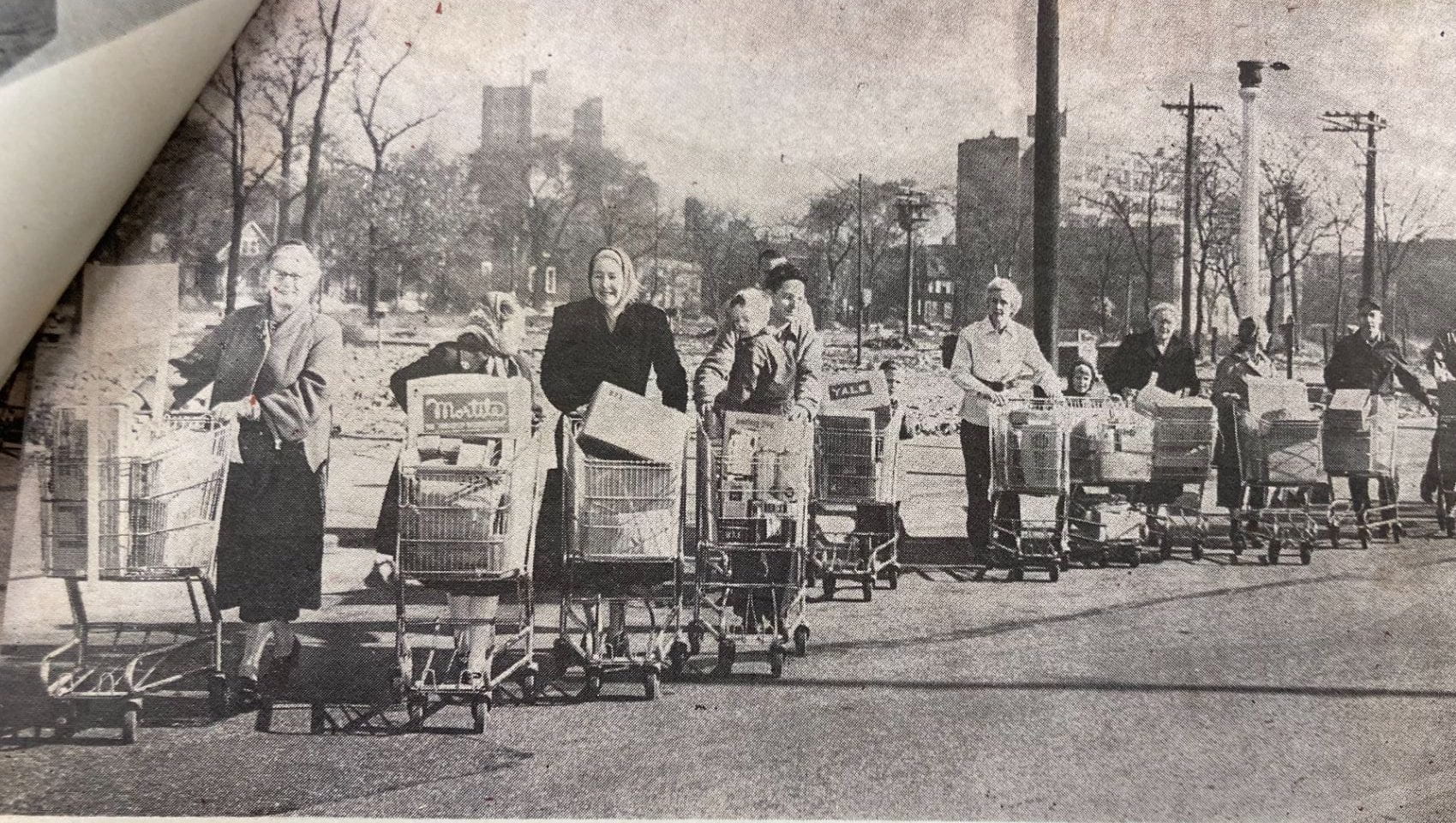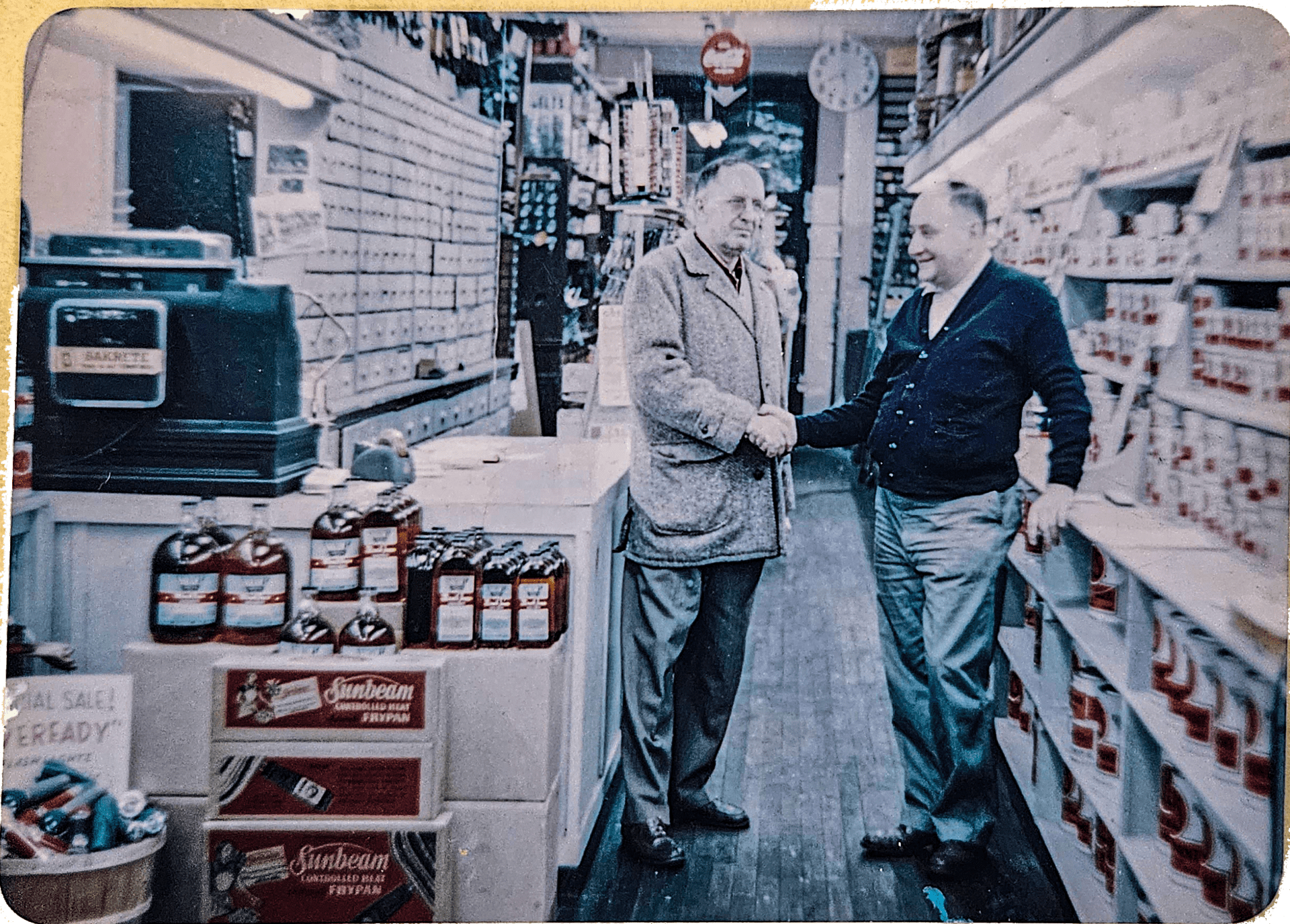A “parade of shopping carts” on Anderson’s last moving day. Courtesy of a September 1963 issue of Hardware Age.
In June of 1956, representatives of businesses in the Hyde Park area traveled to Washington, DC to discuss their issues with urban renewal efforts in the neighborhood with the United States House of Representatives.1 The hearing was the culmination of months of effort from the Hyde Park Business and Professional Association to advocate for a plan for displaced merchants in the wake of urban renewal, a fight that resulted in the creation of Kimbark Plaza.2 These businessmen hadn’t meant to become crusaders against urban renewal; in fact, most of them supported it. But when the Chicago Land Clearance Commission made clear that there wouldn’t be any guaranteed place for displaced merchants in the new shopping centers, the Association took action.
The Hyde Park Business and Professional Association, originally the 55th Street Businessmen’s Association and the 53rd Street Businessmen’s Association, formed in 1956 in reaction to imminent displacement of most of the 55th street businesses, which had previously far outnumbered those on 53rd.3 When the 55th Street Businessmen’s Association was founded in the mid 1910s, it was one of many such organizations that existed along practically every commercial street in Chicago.4 By the time of urban renewal, however, it was one of the oldest and most respected associations of its kind in the city. Along with their yearly “Fish Dinner” and contest for the best decorated holiday windows, the organization supported community beautification efforts, sponsored banquets for the UChicago Football team, and organized other civic-minded activities.5
By the 1950s, however, the reality of urban renewal began to hit home. Many longtime merchants were forced to move or anxiously await demolition without any guarantee of new locations for their stores, many of which had cultivated a Hyde Park clientele for decades. In a widely reported act of protest, Ted Anderson, the owner of a 55th Street hardware store (and onetime president of the association), borrowed carts from the Hyde Park Co-Op to organize a parade moving his inventory.6 In response to the threat of displacement, the Businessmen’s Association created a new Redevelopment Subcommittee,wrote letters to the Hyde Park Herald, and, eventually, appeared before the United States Congress.7 The merchants didn’t want to reverse urban renewal, which they hoped would replace their dilapidated buildings8—supporting urban renewal fulfilled the same civic obligations as window competitions or streetlights. However, the merchants advocated to amend the plans for the new Hyde Park Shopping Center. According to existing laws, the developers of the shopping center would be able to sell the spots to whoever they wanted to, meaning chains could potentially outcompete displaced neighborhood businesses. Despite their efforts, the developers found enough popular support following the placement of the Hyde Park Co-Op that the shopping center stayed open to chains.9
Despite mixed success changing the 55th Street Shopping Center, a number of business people decided to take matters into their own hands. Newspaperman Edward Ramsay gathered several displaced business owners—most of them from the former 55th Street Businessmen’s Association. Together, they collected cash and a small business loan to buy the land for the eventual Kimbark Plaza. Kimbark Plaza was cooperatively owned by its occupants and intended to host only independent small businesses, ideally those that previously existed in Hyde Park before urban renewal. Besides Anderson’s and Mitzie’s Flowers, founding stores included Breslauer’s Department Store, Mr. G’s Grocery,10 and, later on, longtime institutions like Kimbark Beverage Shoppe. This cooperative shopping center model was the first of its kind in the country. Only much later did chain stores like CVS begin to encroach, with the University of Chicago eventually becoming the largest owner.11
As for the Hyde Park Business and Professional Association, it went through another name change in 1986, becoming the Hyde Park Chamber of Commerce.12 In this role, it continues today to promote street planters and cleaners, and provide advertisements and support for local businesses. Somehow, they’ve lasted, simultaneously fighting and supporting urban renewal and gentrification.
Footnotes
- “Hearing Before Subcommittee No. 2 of the Select Committee on Small Business”
- Hyde Park Historical Society, boxes 51 and 56
- “HP Business Ass’n Elects Leaders”
- “President’s Cabinet Congress,” “The Daily News Almanac and Yearbook”
- “At B & P Assoc. Annual Dinner,” “55th Street Business Men’s Annual Fish Dinner,” “Thousands Jam Light Up Ceremony,”“UC Settlement to Enjoy Merry X-Mas Spirit,” “Business Men Set Up Hyde Park Dollar Day”
- “Bulldozers and Businessmen,” Hyde Park Historical Society boxes 51, 56
- “Hearing Before Subcommittee No. 2 of the Select Committee on Small Business”
- Hyde Park Historical Society, Box 72
- Hyde Park Historical Society Hyde Park Co-op Records, Box 1
- Hyde Park Historical Society, Box 51, 56, Pharo, “Kimbark Beverage Shoppe”
- Aliaga, “Kimbark Plaza”
- Hyde Park Historical Society Box 33, Folders 6-11
Bibliography
“55th Street Business Men’s Annual Fish Dinner…South Side’s Classic Civic Banquet is Huge Success.” Hyde Park Herald, December 6, 1947, 1.
“55th Street Shops Seek Hyde Park Relocation Sites.” Daily Maroon, October 18, 1963, 3. Available through UChicago Campus Publications.
“After 20 Years, Mitzie Moves–But not Far.” Hyde Park Herald, October 23, 1957, 3.
Aliaga, Kenneth. “Kimbark Plaza to Welcome CVS as Early as March.” Chicago Maroon, January 18, 2005.
“At B & P Assoc. Annual Dinner.” Hyde Park Herald, July 3, 1957, 1.
“Bulldozers and Businessmen—Anderson faces Redevelopment.” Hyde Park Herald, April 27, 1955, 3.
“Business Men Set Up Hyde Park Dollar Day.” Daily Maroon, October 4, 1940, 3. Available through UChicago Campus Publications.
“Everybody’s Business.” Hyde Park Herald, November 22, 1955, 9.
“Famous Annual Fish Dinner of 55th St Business Ass’n Treat for Tired Tradesmen and Their 250 Happy Guests.” Hyde Park Herald, December 6, 1945, 1.
“Grand Opening.” Hyde Park Herald, April 8, 1953, 1.
“Hearing Before Subcommittee No. 2 of the Select Committee on Small Business House of Representatives, Eighty Fourth Congress, Second Session, Pursuant to H. Res. 114, A Resolution Creating a Select Committee to Conduct a Study and Investigation of the Problems of Small Business.” (Washington: Select Committee on Small Business, 1956). Made available through Google Books.
“HP Business Ass’n Elects Leaders.” Hyde Park Herald, February 22, 1956.
Hyde Park Historical Society Collection, Boxes 26, 33, 37, 51,51a, 56, 60, 62, 72, Hanna Holborn Grey Special Collections at the University of Chicago Regenstein Library, Accessed July 2023.
Hyde Park Historical Society Hyde Park Co-Op Records, Box 1, Hanna Holborn Grey Special Collections at the University of Chicago Regenstein Library, Accessed July 2023
“Hyde Park People, Places, Things: Do you Remember Anderson’s Hardware Store?” Hyde Park Herald, July 8, 2009, 4.
“LCC Heads Inefficient, H. P. Businessmen Say.” Hyde Park Herald, December 19, 1956.
Pharo, Zoe, “Kimbark Beverage Shoppe Sold Closes Temporarily.” Hyde Park Herald, July 26, 2023.
“President’s Cabinet Congress.” Chicago Commerce, (Chicago: Chicago Association of Commerce, 1914). Made Available through Google Books.
“Segregation Argued.” Chicago Maroon, January 19, 1962, 1-2. Available through UChicago Campus Publications.
“Thousands Jam Light Up Ceremony.” Hyde Park Herald, September 24, 1953.
“UC Settlement to Enjoy Merry X-Mas Spirit.” Daily Maroon, December 15, 1950, 3. Available through UChicago Campus Publications.
The Daily News Almanac and Yearbook, 1920. Langland, James, ed. (Chicago: Chicago Daily News, 1919). Made available through Google Books.


